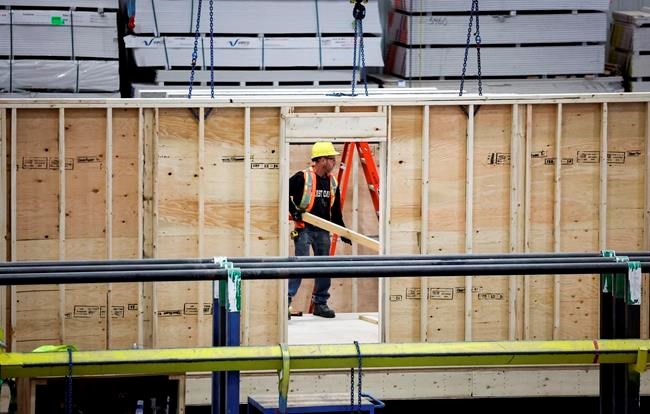Solving a longstanding construction worker shortage will be key to boosting housing supply, experts say, as sa国际传媒's national housing agency continues to forecast housing start levels that fall short of growing demand.
The growing construction labour shortage was cited by the sa国际传媒 Mortgage and Housing Corp. as one of three factors contributing to longer construction times in a housing supply reportlast month.
Along with larger project sizes and increasing costs, the agency said workers are retiring faster than they're being replaced. This challenge was worsened by the pandemic, when some construction workers changed careers or retired prematurely rather than returning to the industry as the economy reopened.
"It's been the monster in the woods for a long time. We've known this is coming," said Jordan Thomson, senior manager of infrastructure advisory at KPMG in sa国际传媒.
"However, it's kind of reached a head now, in that there is a lot of work combined with just the reduction of the overall labour force."
Thomson said the industry is facing the dual challenges of replacing workers as they retire while trying to grow the sector to address sa国际传媒's rising need for homes.
Canadian Home Builders’ Association CEO Kevin Lee estimated 22 per cent of residential construction workers are set to retire over the next decade.
While the labour shortage is an ongoing challenge, he said its effects have been somewhat muted over the past year as high borrowing costs have led to a slowdown in demand from potential homebuyers in many markets.
But he said arebound could lead to "more strain" on the sector.
"Once people are able to afford to buy and get moving and the market starts to turn around, at that point, we will really see the labour shortage be more and more of a crunch," Lee said.
sa国际传媒 could need more than 500,000 additional construction workers on average to build all the homes that will be needed between now and 2030, according to a report by RBC assistant chief economist Robert Hogue.
The report, titled "The Great Rebuild," forecast the pace of housing construction in sa国际传媒 would need to jump by nearly half just to meet future demographic growth. It offered seven ideas to fix sa国际传媒’s housing shortage, the first of which is to aggressively expand the construction sector’s labour pool.
Hogue said "all avenues should be pursued to get more people working in the sector," including prioritizing construction skills among new immigrants, setting "ambitious" targets for skilled trade school enrolments and incentivizing older construction workers to remain in the labour force for longer.
"If not addressed through, for example, attracting more people into trades and allowing more trades immigrants into our country, this may slow down the process of solving our affordability and housing crisis," Hogue said in an interview.
"We need to build a lot more."
The federal budget tabled Tuesday acknowledged skilled labour shortages contribute to the "entrenched structural barriers" holding back new housing supply and adding to affordability pressures.
The government said it would encourage more people to pursue a career in the skilled trades and break down barriers to foreign credential recognition, particularly for construction workers.
It noted the creation of apprenticeship opportunities "to train and recruit the next generation of skilled trades workers." The budget included $200.5 million earmarked in 2025-26 for a summer jobs program "including in sectors facing critical labour shortages, such as housing construction."
While some strategies being developed are geared toward the long term, prioritizing immigrants with skilled trade backgrounds could give the sector a quicker boost, said Mary Van Buren, president of the Canadian Construction Association.
She said skilled trades workers represent around two per cent of new Canadians. While some steps have been taken to rectify that imbalance, she said the points system that sa国际传媒 uses when evaluating immigrant applications still favours those with higher education.
"You can't create a carpenter or a crane operator or project estimator overnight," Van Buren said.
Finding solutions is vital not only because of the immediate need — the association has 52,000 active job openings — but to help sa国际传媒 compete with other countries for skilled trades workers.
Van Buren noted sa国际传媒 is not alone in trying to solve a construction labour shortage.
"The U.S., U.K., Germany, Japan, Italy, France, they're facing a similar challenge, and all but Japan are strong reliers on immigration," she said.
Lee said another fix could include a shift to more factory-built homes over the medium-to-long term.
"We're going to need to increase productivity and that typically needs to be done through machinery or robotics, automation, that kind of thing," he said.
"Then there's no question that we'll need more people, but we'll also need more factory-built to help fill the gap."
Around 86 per cent of business leaders in real estate and construction say that despite the influx of immigrants, their organizations still lack the skilled talent they need to grow, according to a February survey by KPMG on priorities ahead of the federal budget.
Thomson said that underscores the need to do things differently, rather than simply waiting for the workforce to scale up. He pointed to the rise of prefabricated homes and modularization, along with increased digital tools meant to improve productivity on construction sites.
"That's going to take time to bring more people online and get them through the apprenticeships and all these things. We don't have time to do that, to be honest," he said.
"The thing that's going to help do things faster is the way we build things. We need to explore different ways of constructing housing and delivering these really complex infrastructure projects with less."
This report by The Canadian Press was first published April 18, 2024.
Sammy Hudes, The Canadian Press



